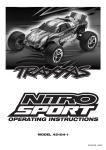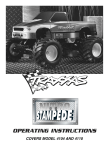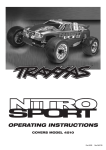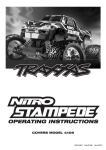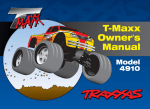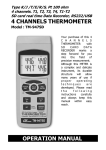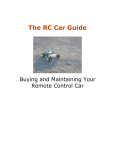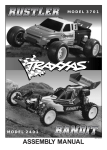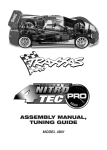Download OPERATING INSTRUCTIONS - notices patrick modélisme
Transcript
OPERATING INSTRUCTIONS MODEL 4910 WARNING! FOLLOW ALL THE INSTRUCTIONS IN THIS AND THE ACCOMPANYING MANUALS IN ORDER TO AVOID SERIOUS DAMAGE TO YOUR MODEL. IF THESE INSTRUCTIONS ARE NOT FOLLOWED, THE RESULTING DAMAGE WILL BE CONSIDERED ABUSE AND/OR NEGLECT, THEREBY RELEASING BOTH TRAXXAS AND YOUR DEALER FROM ANY FURTHER WARRANTY RESPONSIBILITY. INTRODUCTION Thank you for purchasing the Traxxas T-Maxx. This sophisticated truck incorporates many special features including 4 wheel drive, forward and reverse operation, two speed forward and two speed reverse transmission, the EZ-Start™ electric starter, and the reliable TRX Pro.15 engine. This manual contains the instructions you will need to operate, and maintain your T-Maxx. Look over the manual and examine the T-Maxx carefully before running it. If for some reason you think the T-Maxx is not what you wanted, then do not continue any further. Your hobby dealer absolutely cannot accept a T-Maxx for return or exchange after it has been run. Please read ALL of the Operating Instructions and Precautions before attempting to drive the T-Maxx. Even if you are an experienced R/C enthusiast, continue reading to learn about T-Maxx’s unique features. Pay special attention to the mechanical and safety precautions outlined in the manual. If you have any questions about your new model, feel free to call Traxxas’ technical support line toll-free at 1-888-TRAXXAS (1-888-872-9927) Outside the U.S. call 972-265-8000. Technical support is available Monday through Friday, from 8:30am to 9:00 pm central Time. Technical assistance is also available through our website at www.traxxas.com (E-mail us at [email protected]). We hope that you will enjoy many hours of fun with your new T-Maxx. FUEL CAUTION: ALWAYS FOLLOW THE PRECAUTIONS PRINTED ON THE CONTAINER OF FUEL. KEEP IT AWAY FROM FLAMES AND CHILDREN. THE MIXTURE IS FLAMMABLE AND POISONOUS. Fuel is the most critical component for making your engine perform properly. Improper fuels will cause hard starting, poor performance, and excessive wear on the engine. For the best performance from your TRX Pro.15 engine, use Traxxas Top Fuel™. Traxxas Top Fuel is the only model engine racing fuel which exceeds all of the Traxxas engine warranty requirements, is specially formulated to resist heat, and is guaranteed to provide the best performance and longest life from your Traxxas engine. Traxxas cannot guarantee the quality and consistency of other manufacturers’ fuels. If Traxxas Top Fuel is not available from your hobby dealer, the fuels listed below have been tested by Traxxas and determined to be satisfactory for use in the TRX Pro.15. Dynamite Blue Thunder Power Master Formula 16 Byron’s Originals Race 1000/2000 Morgan’s Omega (Omega fuel is an airplane fuel which may be used. The higher oil content however, will not deliver the same performance and tuning ease as a good, special-purpose car fuel) Some fuels are capable of destroying your TRX Pro.15 engine! If you must use a fuel other than those listed, contact TRAXXAS, at 1-888-TRAXXAS, to find out if the fuel is safe for use with TRX engines. CAUTION: ALWAYS FOLLOW THE PRECAUTIONS PRINTED ON THE CONTAINER OF FUEL. KEEP IT AWAY FROM FLAMES AND CHILDREN. THE MIXTURE IS FLAMMABLE AND POISONOUS. FUEL BOTTLE Fuel is usually purchased by the gallon or quart, so a smaller bottle with a dispensing tube is required to fill the fuel tank. The fuel tank in the T-Maxx has a capacity of 125cc. The fuel bottle should always be capped to prevent the fuel from evaporating and becoming contaminated with debris or moisture. The alcohol and nitro contents of the fuel will evaporate, thus upsetting the fuel balance and spoiling the fuel. Do not use old or dirty fuel! Traxxas #5050-Fuel Bottle PERSONAL SAFETY PRECAUTIONS Every precaution outlined in this manual needs to be followed to help ensure safe operation. Operate your T-Maxx sensibly and with care and it will be exciting, safe, and fun for you and your spectators. Failure to operate your T-Maxx in a safe and responsible manner could result in property damage and serious injury. You alone must see to it that the instructions are followed and the precautions are adhered to. The T-Maxx is not intended for use by children without the supervision of a responsible adult. Traxxas shall not be liable for any loss or damages, whether direct, indirect, special, incidental, or consequential, arising from the use, misuse, or abuse of this product and any chemical or accessory required to operate this product. • The fuel is dangerous and poisonous. Follow all of the directions and precautions on the fuel container. • The fuel can look like a cool drink to a young child. Keep it out of children’s reach. • The fuel is flammable. Do not allow sparks, flame, or smoking in the presence of model fuel. 2 • The engine emits poisonous carbon monoxide gas. Always run the model in a well-ventilated area. Never attempt to run the engine indoors. • The engine and exhaust become extremely hot during use. Be careful not to touch these parts, especially when refueling. • Do not drive the T-Maxx at night. • Never, under any circumstances, operate the T-Maxx in crowds of people. The T-Maxx is very fast and could cause injury if allowed to collide with anyone. • Because the T-Maxx is controlled by radio, it is subject to radio interference from many sources that are beyond your control. Since radio interference can cause momentary losses of radio control, always allow a safety margin in all directions around the model in order to prevent collisions. • The engine can be very loud. If the noise makes you uncomfortable, wear ear protection. Be considerate of your neighbors by not running your model early in the morning or late in the evening. • Most importantly, use good, common sense at all times. Contact Traxxas for assistance: 1-888-TRAXXAS. 972-265-8000 (outside USA). E-mail us at [email protected] 7.2v BATTERY PACK AND CHARGER The EZ-Start™ electric starter requires a 7.2 volt rechargeable nicad battery pack. The battery pack straps to the bottom of the EZ-Start™ control box with the supplied tie wraps. The battery pack must be fully charged in order to start the engine. It can be recharged with an overnight “wall charger”, a peak-detecting charger, or a 15-minute quick charger. All are available from a hobby dealer. REQUIRED EQUIPMENT To operate the T-Maxx, you will need these additional items. All of these items should be available from your hobby shop. 1. “AA” size batteries for your transmitter(8) and receiver(4) 2. Small Phillips head and flat screwdrivers (for adjustments) 3. After-run oil (to protect the engine from corrosion) 4. Spare glow plugs (standard plug, Traxxas part #3230; or heavy-duty plug, Traxxas part #3231). 5. In-line fuel filter (recommended) 6. Spare fuel line (recommended) 7. Hobby-quality, thin CA glue for the tires 8. Hobby knife CHANNEL - The 27 MHZ FREQUENCY BAND is divided into 6 CHANNELS, so that up to six cars can be operated simultaneously. These CHANNELS are referred to by their number and flag color. The chart below lists the channels and their flag colors. 27MHZ 26.995 27.045 27.095 27.145 27.195 27.255 FLAG COLOR BROWN RED ORANGE YELLOW GREEN BLUE CH# 1 2 3 4 5 6 TRAXXAS PART# 2031 2032 2033 2034 2035 2036 CRYSTAL (X-TAL) - The CRYSTAL is the plug-in device that determines which channel the RADIO SYSTEM will operate on. For each CHANNEL, there are two CRYSTALS, one for the RECEIVER and one for the TRANSMITTER. Of those two CRYSTALS, the one marked with the lower number (.455 MHZ lower) must be inserted in the RECEIVER. CLEARING YOUR FREQUENCY - CLEARING your frequency means checking to be sure no one else in the area is operating on the same CHANNEL. You should always do this before operating your model. THE TQ-3 RADIO SYSTEM NICAD (Ni-Cd) - These terms stand for rechargeable, nickel cadmium batteries. These batteries are most economical and can be recharged up to 500 times. The T-Maxx model 4910 is equipped with the 3-channel TQ-3 radio system. The following radio system terms will be used throughout the rest of these operating instructions. NEUTRAL POSITION - The NEUTRAL POSITION is the standing position that the SERVOS seek when the TRANSMITTER controls are at neutral. THREE-CHANNEL RADIO SYSTEM - The radio system in your model consists of the RECEIVER, the TRANSMITTER, and the SERVOS. It has three channels, one to operate the throttle, one to shift the transmission, and one to operate the steering. TRIM - TRIM is the fine-tuning adjustment of the NEUTRAL POSITION of the SERVOS. This adjustment is made by turning the throttle and steering trim knobs on the face of the TRANSMITTER. Antenna Throttle Neutral Adjust Steering Wheel Throttle Trim Steering Trim Reverse Shift Forward Shift Throttle Trigger Power Switch Battery Compartment Power Indicator Servo Reversing Switches TRANSMITTER - The TRANSMITTER is the hand-held radio unit which sends throttle and steering instructions to the model. RECEIVER - The RECEIVER is the radio unit inside the model which receives signals from the TRANSMITTER and relays them to the SERVOS. INSTALLING TRANSMITTER BATTERIES Install 8 “AA” batteries into the bottom of the transmitter as shown in the drawing. SERVO - The SERVOS are the small motor units in the model which operate the steering, shifting and throttle mechanisms. FREQUENCY BAND - The FREQUENCY band is the radio frequency that the transmitter uses to send signals to the model. All Traxxas RTR models operate on a 27 MHZ FREQUENCY BAND. Contact Traxxas for assistance: 1-888-TRAXXAS. 972-265-8000 (outside USA). E-mail us at [email protected] 3 INSTALLING RECEIVER BATTERIES The receiver battery holder is located underneath the battery cover. Remove the battery cover by removing the two 3x10mm countersunk self-tapping screws (underneath the chassis). The ON/OFF SWITCH BATTERY COVER on/off switch is mounted in the cover. Install 4 “AA” batteries into the battery holder. Alkaline batteries should be used. Place the battery holder into the battery cover with the cushioning foam. Secure the battery cover to the chassis using the two 3x10mm countersunk screws. should illuminate. A flashing red light indicates weak batteries. Weak batteries will limit the range of the radio signal between your transmitter and receiver. Loss of the radio signal can cause you to lose control of the truck. 3) Turn the truck on. Tthe switchis located on the battery cover. The servos should jump and move to their idle (neutral) positions. NEVER TURN THE TRANSMITTER OR RECEIVER OFF WHILE THE ENGINE IS RUNNING. THE MODEL COULD RUN OUT OF CONTROL. (The on/off switch only turns the receiver on and off. It does not turn off the engine.) 4) With the front wheels off the ground, operate the steering control on the transmitter (channel 1). Check for rapid operation of the steering servo and that the steering mechanism is not loose or binding. If the servo operates slowly, check for weak batteries. Turn the “steering trim” control on the transmitter to adjust the servo so that the front wheels are pointing straight ahead. Check to be sure that the wheels do not turn more in one direction than in the other. FRONT 0˚ TOE-IN Wheels pointing straight ahead RADIO SYSTEM OPERATION Your radio system was pre-adjusted before it left the factory, however, the adjustment should be checked prior to running the truck. 1) Before you ever turn your radio system on, you must “clear” your frequency. There are six different channels numbered 1 through 6. Each of the six channels is represented by a color. Look at the crystal in the back of the transmitter to determine which of the channels your truck is operating on. Clearing your frequency means checking to be sure that no one else in the area is operating on the same channel. 5) Operate the throttle trigger on the transmitter to ensure that the throttle servo is operating properly. When the servo is in the neutral position, the carburetor should be in its idle position (you will adjust the engine idle speed later). When the throttle trigger is pulled all of the way, the carburetor should be in the fully open position. When the throttle lever is pushed forward, the brake should be locked and the throttle should not close any further than when at idle. 2) TIP: Always turn the transmitter on first and off last. This will prevent the model from receiving stray signals and running out of control. Slide the transmitter switch to the “on” position. A steady red light RADIO SYSTEM ADJUSTMENTS • THROTTLE NEUTRAL ADJUST • SERVO REVERSING SWITCHES The throttle neutral adjustment is located on the transmitter face and controls the forward and reverse travel of the throttle trigger. There are two settings, 50/50 which allows equal travel for both forward and brake, and 70/30 which allows more travel for throttle and less for brake. Change the adjustment by pressing the button and sliding it to the desired position. 50/50 is the recommended setting while running the T-Maxx. On the front of the transmitter there are three switches. One for throttle, one for steering, and one for shifting. Moving the switches reverses the direction of the corresponding servos. For example, if you turn your steering wheel right and the model moves left, then switch the steering servo reversing switch to correct the servo direction. You may need to adjust the corresponding trim control after moving a servo-reversing switch. 50% FORWARD 50% E BRAK TOTAL TRIGGER MOVEMENT 4 Contact Traxxas for assistance: 1-888-TRAXXAS. 972-265-8000 (outside USA). E-mail us at [email protected] 6) Operate the forward/reverse shift button on the transmitter. With the shift button pushed down, the truck will only operate in forward motion. Pushing up on the shift button shifts the transmission into reverse. Check for normal operation of the shifting servo. In reverse, the shifting servo should extend the transmission shifter from the transmission housing. 2. Quickly re-seat the tire bead into the rim and allow to dry. 3. Repeat step 1 at several points around the tire until it is secured to the wheel. 4. Allow the CA glue to completely cure before driving the vehicle. NOTE: The acetone in finger nail polish remover should dissolve any glue that may come in contact with your fingers. STARTING THE ENGINE STEP 1: INSTALL THE AIR FILTER PREPARING TO RUN • INSTALLING THE EZ-START BATTERY Use tie wraps to secure a fully-charged 7.2 volt battery back to the EZ-Start control box. Plug the battery connector into the face of the control box. The plug will only go in one way. Remove the protective cap from the carburetor air intake. Install the rubber air filter base and pre-lubed foam element onto the carburetor intake. The foam air filter element may be cleaned and reused. Always be sure the filter element is oiled properly before running the engine. For the best filtration, use the type of oil made for foam air filters. It should be available locally from motorcycle shops and small engine repair shops. Lightweight motor oil or after-run oil may also be substituted. When the element gets dirty, clean it with dish soap and rinse. Next, saturate it with oil and then squeeze out the excess oil. For extremely dusty conditions, special two or three-stage, pre-lubed filters are available from Traxxas (Part #4062 and #4063). • ANTENNA SETUP AIR FILTER Locate the plastic tube and the antenna tip (supplied in the bag with your instructions). Insert the black antenna wire, extending from the receiver housing, RECEIVER into one end of the tube and HOUSING push it all the way through. Insert the tube into the antenna mount on top of the receiver housing. Fold the remaining antenna wire over the top of the antenna tube and secure it with the vinyl antenna tip. Under no circumstances should you ever cut your antenna wire. Its length is specially tuned to the frequency band, and cutting it could severely shorten the radio’s range. On top of the transmitter, fully extend the chrome telescopic antenna. HIGH SPEED NEEDLE STEP 2: FILL THE FUEL TANK Use a small fuel bottle or bulb to put fuel into the tank. Only fill the tank to the bottom of the fill neck. The T-Maxx can carefully be refueled while the engine is running. STEP 3: HIGH-SPEED MIXTURE SETTING Note: Your carburetor has been factory preset for break-in. Do not readjust your carburetor settings unless you suspect a problem. The following steps are for reference only. GLUING THE TIRES The truck tires should be glued to the rims to prevent them from spinning inside the tire. CAUTION: Wear eye protection to prevent injury from glue spattering into your eyes. 1. Glue the tires to the rim by pulling the tire back from the rim and placing a drop of thin CA glue onto the bead. The high-speed mixture screw controls how much fuel enters the engine during mid and high-speed operation. Turn the highspeed mixture screw clockwise, by hand, until it stops (Do not tighten or the needle may be damaged). Now, turn the mixture screw counter-clockwise 2 1/2 complete turns. Contact Traxxas for assistance: 1-888-TRAXXAS. 972-265-8000 (outside USA). E-mail us at [email protected] 5 STEP 4: SETTING THE IDLE SPEED The idle screw regulates the throttle opening to control the idle speed. The throttle opening at idle should be set as shown in the drawing. The opening should be 1 to 1 1/2 millimeters at the widest point in the opening. The engine may not idle well until it is warmed. removing one of the motor wires and holding te start button for 5 seconds. Reconnect the motor wire and press the start button on the EZ-Start to turn over the engine. Do not hold for more than 5-10 seconds to start the engine. Once the engine has started, it may be necessary to continue to hold the start button to keep the plug lit until the engine has warmed up. Note: The red LED on the EZ-Start will light when the start button is pressed. This indicates that the glow plug is hot (ignited). If the LED does not light, make sure that the glow plug connector (blue wire) is firmly attached to the glow plug. If the connection is secure, and the LED still does not light, replace the glow plug with a Traxxas, standard plug #3230. 3) If the engine did not start in step 2, press the plunger 3 times and retry. Continue this sequence until the engine starts. BREAKING-IN THE ENGINE (VERY IMPORTANT!) STEP 5: LOW SPEED MIXTURE SETTING This screw meters the fuel at low speeds. The low-speed mixture screw is located in the end of the carburetor, inside the throttle arm. This screw controls how much fuel enters the engine at idle and low throttle. This adjustment will smooth the idle and improve acceleration to mid-speed. Make this adjustment with the throttle closed, after setting the idle. Gently turn this screw clockwise until it stops against the needle seat. Be very careful as it is difficult to know when the needle has seated due to the thread holding material on the needle’s thread. Overtightening of the screw may result in damage to the needle seat. Now turn the low-speed mixture screw counterclockwise 1 3/4 turns. STEP 6: PRIME THE ENGINE Press the primer button (built into the fuel tank) several times until the fuel moves through the fuel line and into the carburetor. Primer Button STEP 7: SHUTTING OFF THE ENGINE Before starting the engine it is important to know how to shut it off. The correct method is to pinch and hold the carburetor’s fuel line while running at idle speed until the engine dies. STEP 8: START THE ENGINE Before starting your engine, review the safety and driving precautions in this manual. 1) Turn the radio system on (transmitter then receiver). Place the truck against a curb or some other immovable object to prevent it from moving forward. CAUTION: TRX ENGINES MUST BE BROKEN-IN FOR MAXIMUM LIFE AND HIGHEST LEVEL OF PERFORMANCE. THIS PROCESS MUST NOT BE SKIPPED. A SHORTCUT HERE COULD SHORTEN THE ENGINE LIFE. Once your engine is running, it must be broken-in. The key to breaking in your engine is patience. The break in time will take about 1 to 11/2 hours. During the break-in period, your engine may appear to malfunction with symptoms such as stalling, inconsistent performance, and fouled glow plugs. Don’t give up on it! These are just “break-in pains” that every new engine has to go through. They will disappear once you get through the break in period. Just keep it running, and throttle on and off as smoothly as you can. Sudden bursts or releases of the throttle can stall your engine. Resist the temptation to tune the engine for performance and/or run for extended times at wide open throttle. Soon, after about the fourth tank of fuel, your patience will pay off with solid, consistent, performance. DURING BREAK IN... • Special break-in fuels are not required. • Drive the model on a smooth hard surface. • If possible, avoid running on very hot, humid days. • Run with the body off for extra engine cooling. • Do not allow the fuel tank to run completely empty, leading possibly to a burned plug. An extremely low fuel level causes the fuel mixture to be too lean. • Keep extra glow plugs handy. The break-in process, because of the engine running rich, can cause deposits to form on the glow plug, leading to failure. • Turn the mixture screw (needle) clockwise (in) to lean the mixture and counter-clockwise (out) to richen the mixture. THE FIRST TANK OF FUEL 2) Connect the plug from the EZ-Start control box into the connector mounted in the rear body mount of the truck. The plug is keyed so it will only insert one way. Preheat the plug by Once the engine is started, drive the model slowly for the first few minutes to warm the engine. Ease in and out of the throttle slowly. Vary your speed between low and medium throttle until the first tank of fuel is almost empty. Do not run at full speed during the first tank of fuel. Do not rev the engine with the wheels off the ground. High, no-load RPMs can damage the engine, usually resulting in a broken connecting rod. Stop the engine and allow it to cool for 5-10 minutes before proceeding. DRIVING PRECAUTIONS • The radio system is not waterproof. Avoid driving through puddles, wet grass, or mud. Water could damage the electronics. • Do not continue to operate the T-Maxx with low batteries. After the battery power drops below a certain point, the model will continue with the last command it had from the transmitter. Indications of low battery power include slow operation and sluggish servos. On the transmitter, a flashing red light indicates low transmitter batteries. • Do not drive the T-Maxx at night, on public streets, or in large crowds of people. 6 • If the T-Maxx becomes stuck, do not continue to run the engine. Remove the obstruction before continuing to drive. • Do not attempt to push or tow objects with the T-Maxx. • The T-Maxx is controlled by radio. It is subject to radio interference from many sources beyond your control. Since radio interference can cause momentary losses of control, allow a safety margin around the truck in order to prevent collisions. • Use common sense whenever you are driving your T-Maxx. Intentionally driving in an abusive and rough manner will only result in poor performance and broken parts. Contact Traxxas for assistance: 1-888-TRAXXAS. 972-265-8000 (outside USA). E-mail us at [email protected] TANKS TWO-FOUR If the T-Maxx does not shift into reverse, check the following: Turn the high-speed mixture screw clockwise 150 and run through the second tank of fuel. Repeat this process for the third and fourth tanks of fuel. 1. IDLE SPEED- The engine idle speed needs to be set as low as possible and still allow reliable running. If the idle speed is set too high, the T-Maxx will not shift. 2 1/2 turns out 2. DRIVELINE- If the T-Maxx driveline is heavily loaded, such as being stuck on an incline, it may not shift into reverse. If, accidentally, neither forward or reverse is engaged (neutral), do not rev the engine. Revving the engine with no load can cause serious internal damage to the engine, such as a broken connecting rod. Move the shift button back and forth until a forward or reverse gear is selected. ADJUSTMENTS • SHIFT POINT ADJUSTMENT 2 turns out Important: Do not lean the high speed mixture less than 2 turns out from closed (see illustration). Also, be sure to allow the engine to cool between each run. TANK FIVE AND BEYOND The engine can now be tuned for power. Fine tuning adjustments should be made to the engine when it is at its normal operating temperature. Refill the fuel tank, prime the engine, and restart. Drive the truck for a few minutes until the engine is warm. Turn the mixture screw in (clockwise) 1/16 of a turn and continue driving. Note any increase in speed and performance. Continue to lean the fuel mixture in 1/16 turn increments until you no longer see any performance increase. At this point, the fuel mixture is too lean. Turn the mixture screw back out (counterclockwise) the previous 1 /16 of a turn to reach the optimum fuel mixture setting. Turn the mixture screw out another 1/16 of a turn for non-race applications. This will extend engine component life. This setting will vary slightly with each engine depending upon fuel brand, temperature, humidity, etc. Watch closely for any signs of overheating. These include: - Steam or smoke coming from the engine surfaces - Lagging during high-speed acceleration (as if running out of fuel) - Popping or clattering sound when decelerating (detonation) - Idle speed will surge or possibly diminish to the point of stalling. SETTING THE IDLE SPEED Now that the engine mixture is tuned, the idle speed may be set too high. Set the throttle trim on the transmitter so that the brake on the truck is applied. Next, reset the idle speed by removing the air filter and adjusting the the idle speed screw on the side of the carburetor (see drawing on page 12). Turn the screw out (counter-clockwise) to reduce the idle. Re-adjust the throttle trim on the transmitter as necessary. The idle must be set as low as possible in order for the engine to run reliably. If the idle speed is set too high, forward/reverse shifting performance could be adversely affected. Only set the idle speed when the engine is at its normal operating temperature. FORWARD/ REVERSE OPERATION Forward and reverse gears are selected with the shift button located in the transmitter handle grip. The switch is normally in the down position (forward). To engage reverse, bring the T-Maxx to a complete stop and push the shift button up. Allow at least one second (count “one thousand and one”) and then apply 3/4 to full throttle. Abrupt engine throttle solidly locks the transmission into gear. If you accelerate very slowly after a direction change, the TMaxx may appear to malfunction by slipping as the transmission tries to lock in to gear. To return to forward direction, use the same procedure and move the shift button down. The T-Maxx comes equipped with a two-speed transmission. When the shift point on this transmission is adjusted correctly, it will maximize acceleration and improve drivability. If necessary, use a 2.0mm Allen wrench to adjust the shift point. NOTE: It is important that your engine is properly tuned and has reached full operating temperature before making shift point adjustments. Stop the engine before making adjustments. 1) Stop engine. 2) Remove the large rubber plug from the transmission housing. 3) Look into the hole in the transmission housing and rotate the spur gear until the access hole in the aluminum drum is visible. 4) Once the access hole is visible, hold the spur gear and use your finger to turn the primary gear shaft which extends from the transmission housing (see photo). Note that you will see two set screws through the access hole. As you turn the primary gear shaft counter-clockwise, the first set screw holds the twospeed mechanism to the shaft. Do not loosen this screw. The second set screw is the adjustment screw. 5) Insert a 2.0 Allen wrench through the clutch drum and into the adjustment set screw. (See diagram) Insert 2.0 Allen 6) Turn the adjustment screw 1/8 wrench here. turn clockwise to raise the shift Primary Gear point (later shifts). Be careful Shaft not to overtighten the adjustment screw or you may damage the tension spring. Do not make constant adjustments or you will Do not remove the rubber loosen the locking device. plug from this hole. 7) Turn the adjustment screw 1/8 turn counter-clockwise to lower shift point (earlier shifts). Be careful not to loosen the adjustment screw too much or you may cause the screw and spring to fall out (requiring major disassembly and repair). 8) Use 1/8 turn increments to find the Primary Gear approximate, desired shift point. Shaft 9) Check performance by running a test lap after each adjustment. 10) Use 1/8-1/16 turn increments to fine tune the shift point. NOTE: The transmission may not shift if the adjustment screw is turned too far in (locked in first gear), or too far out (locked in second gear). If the truck has quick acceleration and does not appear to shift, the transmission is never reaching the shift point. The shift point needs to be lowered by turning the adjustment screw counter-clockwise. If the Contact Traxxas for assistance: 1-888-TRAXXAS. 972-265-8000 (outside USA). E-mail us at [email protected] 7 truck has poor acceleration but very high top speed, the transmission is shifting into second gear almost instantly. The shift point needs to be raised by turning the adjustment screw clockwise. • FORWARD TO REVERSE SHIFT ADJUSTMENT Included on the TQ-3 transmitter is a forward/reverse shift button which operates the channel 3, shifting servo. The forward/ reverse shift button has been pre-set at the factory to shift the truck into reverse when the button is pushed up. Do not attempt to make adjustments to the shifter mechanism unless you are experiencing a problem. There is also a shifting trim adjustment on the back of the TQ-3 transmitter. The trim adjustment is factory pre-set for your convenience. You should not have to make any adjustments. If trim adjustments for shifting become necessary, insert a long small screwdriver into the small hole in the back of the transmitter. Do not turn the Shifting Trim screwdriver more than 1/4 turn in either direction. • TOE-IN The T-Maxx comes from the factory with zero degrees of toe-in in the front and one degree of toe-in in the rear. You can adjust the toe-in on the front and rear of the truck. Set the steering trim on your transmitter to neutral. Now, adjust your steering turnbuckles so that both front wheels are pointing straight ahead and are parallel to each other (0 degrees toe-in). This will ensure the same amount of steering in both directions. Adjust the rear toe control links so that the rear wheels have 1˚ of toe-in. Toe-in • CAMBER Positive camber There are two pivot balls which are accessible through the spokes of each of the wheels on the T-Maxx. From the factory, the pivot balls are completely tightened into the suspension arms which gives each of the wheels -1˚ of camber. Loosening the bottom camber pivot ball with a 2.5mm Allen wrench will increase the wheel’s negative camber. You should not adjust the top pivot ball. Loosening the top pivot ball will increase positive camber and will also change the wheel’s toe-in. After running the truck, always CAMBER PIVOT remember to check the front pivot BALL balls to make sure they are tight. • SHOCKS The eight dampers (shocks) on your T-Maxx have the most influence on its handling. Whenever you rebuild your shocks, or make any changes to the pistons, springs or oil, always do it carefully and in sets (front or rear). Piston head selection depends on the range of oil viscosities that you have available. For example, using a two-hole piston with a lightweight oil will give you the same dampening as a three-hole piston with heavier oil. We recommend using PRE-LOAD two-hole pistons with a range of oil SPACERS viscosities from 10W to 40W (available from your hobby shop). The thinner viscosity oils (30W or less) flow with less resistance and provide less dampening, while thicker oils provide more dampening. Use only 100% pure silicone shock oil to prolong seal life. The ride height for the T-Maxx can be adjusted by adding or removing the clip-on spring pre-load spacers. Note that changes in ride height will occur when the changes in damper angle or spring rates are made. You can compensate for ride height changes by changing the pre-load spacers on the dampers. STORAGE After running your T-Maxx, use a good “after-run” product prior to storage. The chemicals used in the fuel attract moisture and can cause moisture and corrosion to form inside the engine. Drain the fuel tank, start the engine and run it until all of the remaining fuel is completely used up. Remove the air cleaner and place the recommended number of drops (usually 6 drops) of the after-run oil into the carburetor. Now, spin the engine for 2-3 seconds with the EZ-Start to circulate the oil. Replace the air cleaner. Never store your T-Maxx with unused fuel in it. Negative camber MAINTENANCE 1) Check the wheels and steering fr binding. Check the operation of the shock absorbers. 2) Check the wiring for any frayed wires or loose connections, including the wires on the EZ-Start quick connector. Fraying or melting of the blue wire on your EZ-Start system can cause your glow plugs to immediately short out. 3) Check the tightness of the grub screws in the collars on the throttle and steering linkages. 4) Check the tightness of the front pivot balls. 5) Check the mounting of the receiver and servos. 6) Check the tightness of the wheel nuts with a wrench. 8 7) Check the fuel tank and all hoses for signs of leaks. 8) Check the operation of the radio system, especially the condition of the batteries. 9) Check the exhaust system for leaks, cracks, or tears. Do not run the car if there are any exhaust leaks. 10) Use Traxxas Nitro Wash spray cleaner to keep the T-Maxx clean of accumulated dirt and oil. Do not spray any radio components with Nitro Wash. Do not spray Nitro Wash into a dirty air filter while it is installed on the engine. 11) The steering servo saver will wear out over time. If the steering becomes loose, the servo saver should be replaced. Contact Traxxas for assistance: 1-888-TRAXXAS. 972-265-8000 (outside USA). E-mail us at [email protected] PAINTING THE BODY • SPRAYING THE BODY * Note: Please read this entire section and plan your paint job before beginning. Read the directions on your bottle or can of paint and shake, mix, or thin the paint, as required. It is very important to avoid breathing the paint vapors, as they are extremely harmful. Spray the paint outdoors in well-ventilated areas only. Apply the paint to the body sparingly and in light coats. Be patient! Let the paint dry fully in between coats. This will prevent accidentally smearing wet paint. Take extra care when masks are being removed. After the body is completely painted, remove the peel coat from the outside of the body. • BUYING PAINT The body supplied with your model is molded from clear polycarbonate so that it will be lightweight and durable. It should be painted on the underside so that the color will not be scratched off while running.The best way to paint the body is by using thinned paints sprayed through an airbrush or spray gun. If you do not have these tools, the next best way is using spray can paints. Whatever paint you use, be sure that it is made for painting Lexan® and polycarbonate. Other types of paints and solvents can attack the body material and cause it to appear foggy. • PREPARING THE BODY The body must be washed thoroughly with dish soap and water to remove any grease or oil (i.e. fingerprints) which may keep the paint from adhering to it. Dry the body completely with a soft, lint-free cloth. Be careful using paper towels on the outside of the body, as they can scratch the plastic. Do not cut out the body until after it is painted. Use the supplied adhesive tape masks to mask the windows. Mask off any stripes or custom effects with either masking tape or special tape made for striping. This special tape is available from automotive paint supply stores and will provide sharper edges than masking tape. For easy, custom-colored striping, automotive pinstriping tape can be applied to the inside of the body and painted over. Be sure that all of your tape and masks are fully pressed down (burnished) so that the paint will not run or bleed underneath. Usually, the darker colors are painted first, followed by the lighter colors. If your paint scheme would be easier to mask by covering the dark areas and spraying them last, be sure the lighter colors are opaque enough to prevent the darker color from showing through. Lighter colors can be backed with silver to help make them opaque. • ENGINE COOLING Notice how the back of the body has been cut to allow cooling and access to the engine. The windshield should be cut out as shown to allow cooling air to reach the engine head. A small opening between the rear body mounts has been cut out for the EZ-Start connector. • DECALS You are now ready to apply the decals. The decals have been die-cut for your convenience. Test the position of the decals before applying them to the body. Once the decals have been applied, they cannot be removed without damaging them. You can spray the body with window cleaner before applying the decals. This will allow you to re-position them. Once positioned, squeegee the cleaner from under the decal. The decal will adhere when it dries. If you have air bubbles in the decals, puncture the center of each bubble with a sharp pin and push the air out. If you have creases along the outer edges of a decal (especially when applied to curved surfaces), use a hobby knife to cut along the top of the crease and overlap the edges. LIMITED WARRANTY INFORMATION Every effort has been made in component design and material selection to make your T-Maxx as durable as possible. Because the model is intended to be a hobby-class model and operate at a much higher level of performance than a “toy,” no warranties can be expressed or implied relating to the longevity of the parts. Parts will wear out and require replacement. If any part of the model appears to be defective, or incorrectly assembled when it is new (before it is used), it will be repaired or replaced at Traxxas’ discretion. This warranty will not cover damage from wear, abuse, neglect, crashes, or water. • TO OBTAIN WARRANTY SERVICE The radio system that is provided with the ready-to-run models is covered by separate warranty on a separate page (included in your documentation package). The radio system warranty does not cover water damage. Due to the special nature of the TRX Pro.15 engine, it is also covered by a separate warranty page provided with your model. Be sure to include a return address and a daytime phone number. MAIL OR SHIP TO: Traxxas reserves the right to make changes, modifications, and improvements to this product without notification, and which may not be reflected in these documents. Upgrades and improvements are not necessarily retroactive. Traxxas may not provide improved or updated components free of charge for models built prior to any change in specification. For technical assistance regarding your model, call 1-888-TRAXXAS (872-9927), 972-265-8000 (outside of the U.S.A.), or E-mail Traxxas at [email protected] For orders and other information, call 972-265-8000 or fax 972-265-8011. If it has been determined that your model is somehow defective, return it to Traxxas with a note describing the problem, and a copy of the purchase receipt or invoice. Do not return to Traxxas without first speaking with a service technician, toll-free, at 1-888TRAXXAS. Drain all fuel and remove all batteries. Remember that the warranty only covers brand new products which are defective right out of the box. All other service will be estimated on an individual basis. Traxxas 1100 Klein Rd. Plano, Texas 75074 9 REBUILDING THE ENGINE STEP 7: To separate the engine from the engine mount, remove the four 3x8mm caphead machine screws. * Note: You will not need to remove the engine mount for a basic rebuild of the engine. Do remove the engine mount if you exchanging the engine under the Lifetime Engine Replacement Plan. STEP 8: Removing the carburetor is not necessary to rebuild the engine, unless you intend to replace the internal bearings of the engine. Remove the carburetor by loosening the 3mm locknut and pulling the carburetor straight up. Do not lose the rubber O-ring. STEP 1: Unplug the blue wire from the glow plug. Remove the fuel line from the carburetor pressure fitting. Disconnect the red and black wires from the EZ-Start motor. STEP 2: Remove the exhaust hangar bolt which secures the tuned pipe to the chassis. Pull the tuned pipe from the header. STEP 9: Use the tip of a small screwdriver to remove the E-clip which holds the clutch bell gear. STEP 11: Grip the flywheel with a pair of pliers (locking pliers work best). Remove the clutch adapter nut with a 10mm deep socket. Hold the engine just above your workbench and tap the flywheel from behind with a non-marring hammer (plastic or wood). Several easy blows may be necessary to release the flywheel and split beveled cone. STEP 10: Remove the clutch bell gear and the clutch shoes. Note that there are two 5x8mm Teflon® washers, one on each side of the clutch bell gear. Check the clutch shoes for excessive wear or cracking around the pin holes. If the clutch shoes are worn to the point that the clutch spring contacts the clutch bell, then the shoes must be replaced. STEP 3: Use a 2.5mm hex driver to remove the four engine mount screws from the bottom of the chassis. STEP 4: Pull the engine out of the truck. Remove the yellow ground wire from the engine mount. Now you can completely remove the engine. STEP 5: Pull the engine from the chassis. Turn the engine so that the throttle linkage to the carburetor will come out. Remove the EZ-Start gearbox by removing the three 3x8mm roundhead machine screws. STEP 6: Remove the 3x23mm roundhead machine screws that fasten the header to the engine. Carefully remove the header to avoid damaging the gasket. STEP 12: The flywheel and the split-beveled cone should pull smoothly off of the crankshaft. 10 STEP 16: The piston and sleeve are a matched set. When the piston and sleeve are disassembled, they must be reassembled in the same orientation. Use a permanent marker to mark the location of the piston in relation to the pinning of the sleeve. STEP 15: Remove the backplate and the starter shaft. STEP 14: Use a 2.5mm Allen wrench to remove the four 3x12mm cap head screws that fasten the cylinder head. Rock the cylinder head gently from side to side to release it from the sleeve. Do not lose the thin aluminum head gaskets. STEP 13: Use a 5/16 inch nut driver to remove the glow plug and copper gasket. STEP 21: Remove the crankshaft by pulling it straight out of the crankcase. STEP 20: To remove the connecting rod from the piston, use a sharp-pointed tool to remove the small metal G-clip in the side of the piston. Do not bend or distort the G-clip or it will have to be replaced. When installing a new connecting rod, use the supplied new G-clip. STEP 19: Remove the connecting rod and piston through the top of the crankcase. STEP 23: Before installing a new connecting rod, you can increase engine life by polishing the crankshaft journal. Use 1200 grit sandpaper to remove the surface scratches followed by liquid metal polish to buff the crankshaft journal to a bright, smooth shine. Rinse thoroughly with denatured alcohol and lube with afterrun oil. STEP 22: The bearings are press-fit into the crankcase. To remove them, the crankcase must be heated with a heat gun or torch. The crankcase will expand with heat and release the bearings. To avoid the possibility of burns or other damage, do not attempt remove the bearings. Clean the bearings by flushing them with denatured alcohol and then place one or two drops of after-run oil on the races. STEP 17: Pull the sleeve straight up and out of the crankcase. If the sleeve will not move, rotate the crankshaft until the sleeve pushes up. STEP 18: Rotate the crankshaft to bottom dead center. Lightly grab the connecting rod with a pair of needlenose pliers and gently pull it off of the crankshaft journal. STEP 24: Use the 1200 grit sandpaper and the liquid metal polish on the wrist pin also. Rinse thoroughly with denatured alcohol and lube with after-run oil. 11 STEP 26: Reinstall the crankshaft into the engine and make sure that it spins freely. Insert the connecting rod and piston assembly through the top of the crankcase. The G-clip normally faces the carburetor. Put a drop of castor or after-run oil in the bottom end of the connecting rod. Use your fingers to gently push the end of the connecting rod over the crankshaft journal. STEP 25: To assemble the connecting rod and piston, place a drop of caster oil in the top end of the connecting rod. Insert the wrist pin through the piston and the top of the connecting rod. Secure the wrist pin with the Gclip. Make sure the G-clip fits securely into the groove machined in the piston. Be careful not to scratch the sides of the piston. STEP 33: Turn the gear over and install the other ball bearing. STEP 32: Install the appropriate size ball bearing into one side of the clutch bell gear. The T-Maxx comes stock with a 20-tooth clutch bell gear which requires 5x11mm ball bearings. STEP 31: Reinstall the backplate and a new backplate gasket with the 3x8mm caphead machine screws. Tighten the screws in small increments, in a criss-cross pattern until all the screws are tight. STEP 35: Install the clutch shoes exactly as shown in the drawing (leading edge engagement). Next, install a 5x8mm Teflon® washer followed by the clutch bell gear (with bearings installed). Install the remaining 5x8mm Teflon® washer followed by the Eclip (see step 9). STEP 34: Install the split-beveled cone onto the crankshaft. Next, install the flywheel. Install the clutch adapter nut with a 10mm deep socket. Grip the flywheel with pliers while tightening the adapter nut. STEP 27: Place another drop of oil on the connecting rod bushing. Rotate the crankshaft several times to distribute the oil. STEP 28: Insert the sleeve into the top of the crankcase. Rotate the sleeve so that the notch in the sleeve will line up with the pin in the crankcase. Holding the engine upside down will make it easier for the sleeve to go over the piston. STEP 29: Install new head gaskets on the head. Use one thick and one thin gasket. Reinstall the head using the 3x12mm caphead machine screws. Tighten the screws in small increments, in a criss-cross pattern, until all the screws are tight. STEP 30: Reinstall the starter shaft. Align the notch in the starter shaft with the crankshaft journal pin (arrow). STEP 36: Reinstall the carburetor, header, a NEW glowplug, and engine mount. Use a new header gasket when re-installing the header on the engine. Reinstall the engine in the truck in the reverse order of removal. Don’t forget to reconnect the yellow grounding wire to the engine mount. The rebuilt engine must now be broken in. 12














